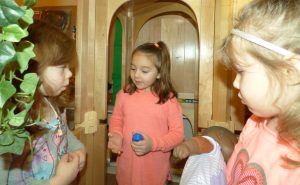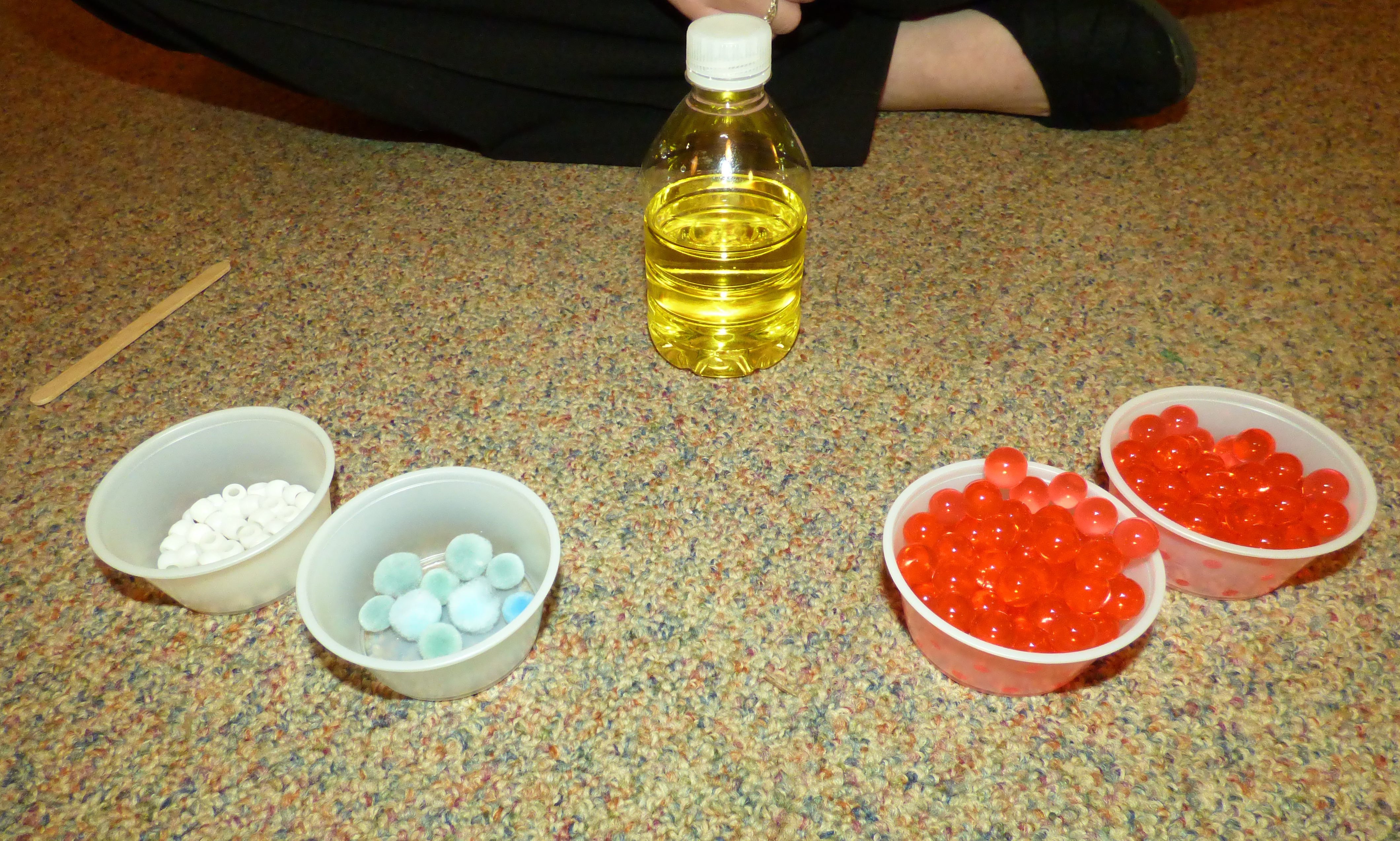This morning, a group of students spent a large chunk of their morning play time designing and implementing a classroom pet store. The students worked diligently to draw various pets that could be sold and decided together how much each pet should cost. It wasn’t long before they pulled out the cash register and started making money and credit cards that people could use to purchase the animals. The name of the pet store is still up for debate but lots of ideas were tossed around. The look of excitement was clearly present on each of their faces and we are anxious to see how this pet store will grow and prosper within the classroom.
Rainy Day Discovery
This morning’s weather proved to be little finicky as it rained on and off for over an hour but that didn’t deter our youngest explorers. We prepared ourselves with boots and raincoats and then embarked on the great outdoors to enjoy the unseasonably warm day. It wasn’t long before a student noticed a small worm making his way up the side of boulder. We theorized about how he was able to hang on to the rock without any arms or legs. We studied how his body would shrink and then stretch as he so effortlessly moved across the rock once he reached the top. Then, before we knew it, there were two worms crawling across the rock. One student proclaimed that there were so many worms out because it was raining and worms love water. The students took turns gently touching the worm and then squealing with joy. It always amazes me what wonderment can be found on what might seem like a dreary day.
Let’s paint the ceiling!
Today in Art class, the students learned about the artist Michelangelo and his work. They read a story about his life and how he sculpted a number of very famous pieces that people travel all around the world to see. They also learned about when he painted the Sistine Chapel and how he had to paint laying down on scaffolding as he covered the entire ceiling with beautiful scenes from the heavens. It was great deal of hard work but the result was a masterpiece.
The pre-k got a chance to create some of their own masterpieces just like Michelangelo did so many years ago.
Parts of a Set
This week we carried our practice subitizing small sets a bit further. Given a set of four rocks, one child acted as the “teacher” and covered any number of rocks with their hand. The second child, “student”, then deduced how many were hidden. They used their knowledge of “four” and the visual clues showing how many were still uncovered. Subitizing and working memory united to build on the children’s growing understanding of sets.
Who will solve the problem?
 Conflicts often arise when children play together. Each is a teachable moment. Although we could easily solve the issue for the children, we prefer to teach them how to find solutions on their own. Responsive Classroom, used here, is one of many programs that model conflict resolution in which the students are actively involved in the process.
Conflicts often arise when children play together. Each is a teachable moment. Although we could easily solve the issue for the children, we prefer to teach them how to find solutions on their own. Responsive Classroom, used here, is one of many programs that model conflict resolution in which the students are actively involved in the process.
Recently, playing “family” has been extremely popular with many of our students. The roles the children take vary from day-to-day and minute to minute. Conflict arises when two people either want to play the same part or one person wishes to control the entire story.
In the conversation below, two children were unhappy because they both wanted to play the same character role. Mrs. Forst invited them to talk . Before Mrs. Forst could begin working with our well-practiced conflict resolution strategy, a third child offered to help them on her own.
Susie: “I want to be the mom, but Henrietta says I can’t.”
Henrietta: “I want to be the mom.”
Georgette: “I know what they could do. Henrietta could be the mom first and then Susie can be the mom.”
Mrs. Forst: “Do you agree Susie?”
Susie: “No.”
Georgette: “I know, they can both be the moms. There can be two moms.”
Mrs. Forst: “Do you both agree?”
Henrietta and Susie: “Yes!”
Mrs. Forst: “You solved your problem!”
The Science of Blood
Yesterday, we took a trip inside our blood to learn about it’s composition. We put our items in the middle of our circle and explained that each of these items represent something that lives in our blood. We started with the large container of yellow water, which we were pretending was our plasma. We explained that plasma is a watery like substance that makes up large portion of our blood. At first, some students were not sure how it could be in our blood because it was not red, which lead us to our second ingredient: red blood cells!
We then added our red blood cells (red water beads) to our blood mixture. The students noticed that the more we added the red blood cells, the more the mixture appeared to be red than yellow. Because of this observation, they concluded that our blood looks red because of red blood cells.
Next on the list were the white blood cells (white beads). We then discussed how our white blood cells are the “soldiers” of our bodies that are always working to keep us from getting sick and help your body get better when you do have a cold or the flu.
Lastly, we discussed how our blood needs platelets (blue pom-poms) because they help our bodies create new skin or scabs when your skin is cut. Each child scoured their bodies for an old boo boo that they could share with the class and naturally they all had an elaborate story to go along with them.
Now that our students have spent some time learning about the composition of our blood, it’s time to learn about how the blood moves throughout our bodies. Bring on the giant, tape, floor heart! Hint: here’s what it looked like last year!
Let it snow, let it snow, let it snow
It was a blustery, wintry, picture perfect Forest Fours day today! Not only was there enough snow to finally go sled riding, but it was also great packing snow. We had giant snow balls and snow-people galore and many discussion about where the fairies go for the winter. We couldn’t have asked for a more perfect morning. I think it’s safe to say that our little snow bunnies quite thoroughly enjoyed themselves.
Drip, drip, drip
Sometimes it is the simplest things that brings joy to our lives. Watching a young child discover the properties of falling water fills me with joy. The wonder and inquiry that is involved is like no other. Somewhere along the way adults lose that wonder, until a child comes along and forces us to see the world through a fresh set of eyes.
[wpvideo 4gKjmT7a]
Go Noodle!
When the winter months start to roll around, there are often days at a time when the students are stuck inside due to the extremely cold temperatures. Wiggly bodies and pent up energy can be difficult to manage in our small classroom, but luckily we have a trick up our sleeves and it goes by the name of GoNoodle.com. Go Noodle is a website that provides hundreds of videos that gets kids exercising, practicing brain building activities, and even has a mindfulness section that helps bring students back to a calm, controlled state of being.
When signing up for our account, the class was assigned a little creature (named McPufferson) who grows and get stronger the more we complete the videos. The students relish in seeing “our guy” gain points and level up to become bigger and stronger with each video. In just a few weeks, our students have already memorized several of the silly songs, motions, and breathing exercises and often talk about them throughout the day.
The website has been a great resource for us to help fight off cabin fever and get our bodies moving. Anecdotally, I also have to admit that it has been a great way to get my heart pumping on those drab, wintery days. If you are interested in signing up at home, the sight is completely free and there is an option to sign up as a parent rather than a whole class. We highly recommend it!
Letter Builders
In the past week, the students have been playing a game during center time called “Letter Builders” where they work with various wooden shapes to build a given letter. At the beginning of the game, the students are given a card with a letter displayed on it and they are asked to figure out which pieces they will need to make their letter. They then take the wooden pieces and place them right on top of the letter card. In most cases, the students exclaim how easy the task is and that they are ready for more of a challenge.

Once the students are comfortable with their abilities to manipulate the shapes, the letter card is then placed on a stand that sits in the middle of the table. The students must now create the letter shape while looking at the letter card from afar rather than directly in front of them. While this seems like it should be an easy task, the children actually must now use their executive functioning skills and working memory to hold the shape of the letter in their minds while searching for the appropriate pieces. Then they must create the shape of the letter in front of them without the help of the card underneath as a guide. The letters that use more straight pieces tend to be the easiest for the students to create, while the letters that use curvy pieces or letter that requires the students to cross the midline prove to be the most challenging. Some of the letters require the students to overlap the pieces, which created an extra challenge for them to tackle.
The last step in the game is when the students must create the letters completely on their own. The letter cards are put away and the student are asked to create the letter completely from memory. This is obviously the most challenging as the students must think about what shapes they will need without an example in front of them to use as a resource. Some students quickly problem solved this issue by looking around the room for the letter they were working on or even looking at a neighbor’s completed letter. The more the students work with the letters and their shapes, the easier the task becomes.
Today, we focused on creating uppercase letters as they are easier to form. Next time we play, the students will be challenged with creating lowercase letters with the wooden shapes. This makes the task slightly more difficult as the students will have to make sure their letter shapes are facing the correct direction. When shifted, even slightly, it can be easy to accidentally create the wrong letter. Letters such as b, d, p, and q look remarkably alike and the students will have to stay focused in order to create the correct letter. We know that our Pre-k Letter Builders will be up for the challenge!






